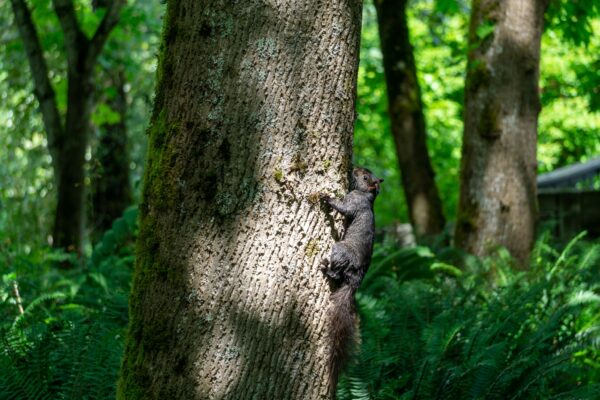Eastern grey squirrel
About This Species
A small number of Eastern grey squirrels (Grey squirrels) were introduced into Vancouver’s Stanley Park in 1909, where they are now thriving residents. In 1966, several escaped from a game farm on Vancouver Island, where they pose a threat to sensitive Garry oak ecosystems. They are native to Eastern North America. These squirrels compete with native squirrel species and birds for habitat, and feed on bird eggs and nestlings. They are carriers of parapoxvirus, which may infect native squirrels and some livestock.
Eastern grey squirrels dig up lawns and gardens, chew through electrical wires, eaves and shingles, and nest in roofs, attics, and chimneys. The squirrels damage fruit and nut trees and vines chewing and stripping bark.
The Eastern grey squirrel is one of seven mammals among the 173 invasive species identified by the Garry oak Ecosystem Recovery Team (GOERT) as a species of concern to Garry oak and associated ecosystems. These areas are home to more plant species than any other terrestrial ecosystem in coastal BC, and many of these species occur nowhere else in Canada. It prefers the tips of the acorns of some oaks, including Garry oaks, which may slow regeneration. They also damage and kill trees by stripping the bark. Eastern grey squirrels are designated as a Regional Containment/Control species by the BC Provincial Priority Invasive Species List.
How to Identify
Eastern grey squirrels have dark to pale grey backs that may be brushed with cinnamon colouring on hips, feet, and head. Ears are buff to grey to white, and tails are white to pale grey. Adult squirrels can be 30 cm long.
Eastern grey squirrels can also commonly be melanistic which means their fur is entirely black. Less commonly is albinism, leucistic or other genetic aberrations leaving their fur to be white.

Take Action
Prevention is the best approach.
-
If you need advice about invasive species on your property or you are concerned about reported invasives in your local area, contact your local government or regional invasive species organization.
prevention tips
To prevent the spread of European grey squirrels, please don’t feed or relocate grey squirrels, keep all compost, garbage and pet food covered and use squirrel-proof bird feeders.
REPORT TO PROTECT BC’S BIODIVERSITY

Use the app
Observe and report to protect BC’s biodiversity

Report through this website
Use our form to tell us what you’re seeing and where.
















